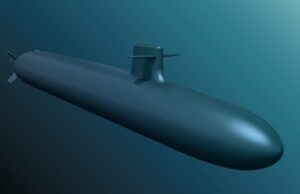France launched the production program of its new third generation nuclear-powered ballistic missile submarines, the Minister of the Armed Forces Florence Parly said Feb. 19.
France plans to procure four new SSBN ballistic missile submarines known as the SNLE 3G in French (Sous-marin Nucléaire Lanceur d’Engin de 3e Génération), with deliveries planned to start in 2035 and continue with one every five years. The vessels will replace the current four SNLE 2G Triomphant-class SSBNs.

The first of the current SSBNs was commissioned in 1997 and the last was commissioned in 2010.
The government plans to replace the current SSBNs in a way to ensure at least one French SSBN is on patrol at sea at all times for nuclear missile deterrent purposes.
Contracting authorities include the French defense procurement agency (DGA in French), which leads the overall project, and the Alternative Energies and Atomic Energy Commission, which leads on nuclear propulsion issues.
Project management will be led by Naval Group and TechnicAtome, with the latter building the nuclear boiler rooms.
The French Armed Forces Ministry said the new SNLEs will expand on the capabilities of the Triomphant-class as well as the Barracuda-class nuclear-powered attack submarine, also designed by Naval Group and currently under construction.
The new submarines are planned to have improved acoustic, hydrodynamic, maneuverability, and quieter propulsion capabilities.
Relatedly, on Feb. 19 Thales said it signed a Memorandum of Understanding with DGA to develop a new sonar suite for the vessels to include a range of sonar arrays and associated processing systems.
“Thales will provide new-generation flank arrays and bow-mounted sonars, a towed linear array based on optical technology (ALRO), and all the other equipment making up the sonar suite (intercept arrays, echo-sounders, underwater telephones). The size of the arrays and the frequency bands they use will deliver unparalleled performance in terms of 3D (azimuth, elevation, range) detection precision,” the company said in a statement.
The sensor data processing system is called the Analyse, Localisation, Identification, Classification Intégrées et Alertes, or ALICIA, and will have a user interface designed to handle the volume and diversity of data to “optimize operator workload and provide decision support.”
Thales said this new sonar suite will be deployed incrementally, with the first system versions and building blocks installed on the current Triomphant-class SNLE 2G starting in 2025 and later version installed on the SNLE 3G in 2035.
“Thales teams have been especially focused on the SNLE 3G project to ensure that it benefits from our very best sonar innovations, which have been taking shape over the last five years as part of nearly 50 years of consistent investments in sovereign R&D to guarantee the invulnerability of France’s SSBNs,” Alexis Morel, vice president of underwater systems at Thales, said in a statement.
“New sovereign sonar array, processing and Big Data technologies will deliver unparalleled performance for the third-generation SSBNs and will also be of benefit to the modernized Triomphant-class second-generation SSBNs,” he added.